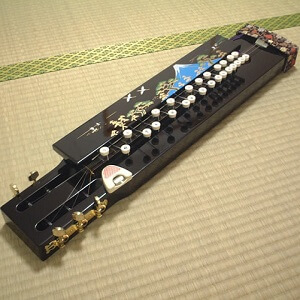Taishogoto
 Taishogoto is a much recent Japanese Stringed Instrument than some others on this list. It was developed in 1912 (during the Taisho period) by Goro Morita in the city of Nagoya, hence the name "Nagoya Harp".
Taishogoto is a much recent Japanese Stringed Instrument than some others on this list. It was developed in 1912 (during the Taisho period) by Goro Morita in the city of Nagoya, hence the name "Nagoya Harp".
Morita was influenced by the Western instruments and he eventually came up with the idea of combining the mechanics of conventional string instruments with typewriter-style buttons to change the notes. The Taishogoto consists of a long acoustic sound box with metal strings on top and numbered typewriter-like keys spread across its length.
The players strums the strings with a pick on one hand while pressing the keys with the other hand to “fret” the notes. The simple mechanics and the ability to produce notes from the Western 12-note scale make it very accessible and easy-to-play for anyone.
The Taishogoto is played in a variety of modern genres, from children’s music to large groups of musicians playing pop music. It’s also a precursor to the Indian instrument Bulbul Tarang & the German Akkordolia.